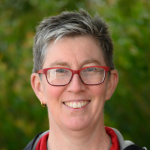
Role at ANSTO
Dr Cath Hughes is currently leading the Isotope Tracing in Natural Systems Research Infrastructure Platform in delivering high quality customised low-level radionuclide, stable isotope and elemental measurements to support world class research, Australian governments, industry, international organisations and ANSTO Operations. She is also conducts research in the Environment Research Theme at ANSTO, managing Australia’s Global Network of Isotope in Precipitation, and helping improve water sustainability and manage radioactive contamination using stable isotopes and artificial or naturally occurring radioactive isotopes as environmental tracers.
Her particular interest is in the use of water isotopes (deuterium, tritium and oxygen-18) to understand the hydrological cycle, and the impact of past and present climate, weather and urban and agricultural water use on water resources. Through case studies in the Murray-Darling and Sydney Basins she aims to promote the routine use of stable isotopes in hydrology and catchment studies and to contribute to a national sampling network which will include time series of rainwater, tapwater and atmospheric water vapour isotopes at sites across Australia. This data forms a basis for not only water resource management, but also isotope forensics, food provenance and climate science.
Closer to home she is involved in research related to the movement of radionuclides in sewage effluent and groundwater in the Sydney region and is working with the IAEA to establish guidelines for the safe application of radiotracers in environmental studies. She has also been involved in IAEA/RCA activities teaching and demonstrating applications of radiotracer technology to coastal engineering and environmental problems in Asia.
Expertise
Isotope hydrology, radiotracing, precipitation, groundwater, surface water, radioactive contamination, biota dose assessment, coastal processes.
Qualifications & Achievements
Cath joined ANSTO in August 1999 and has a PhD in wetland hydrology from the University of Newcastle and an Environmental Engineering (Hons I)degree from the University of NSW.
